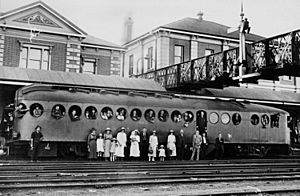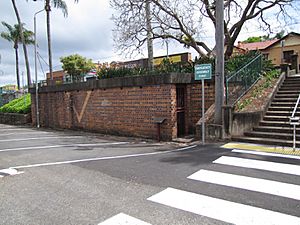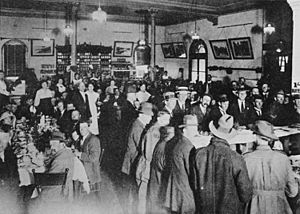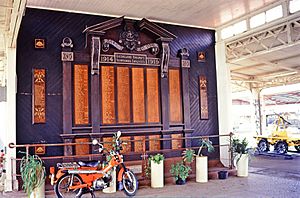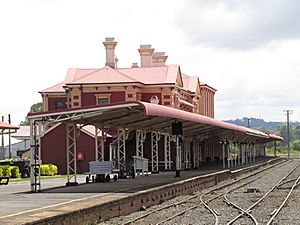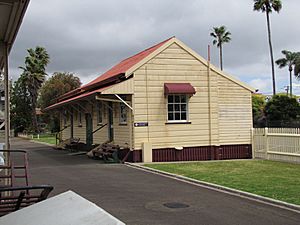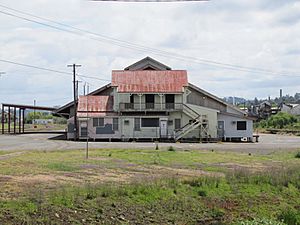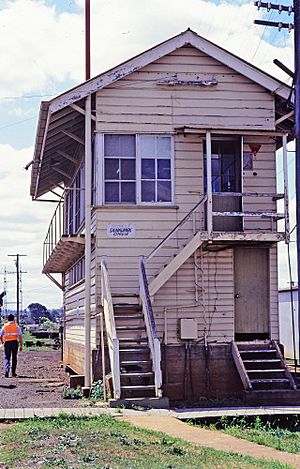Toowoomba railway station facts for kids
Quick facts for kids
|
|||||||||||
|---|---|---|---|---|---|---|---|---|---|---|---|

Station front in July 2013
|
|||||||||||
| Location | Railway Street, Toowoomba | ||||||||||
| Coordinates | 27°33′27″S 151°57′06″E / 27.5574°S 151.9517°E | ||||||||||
| Owned by | Queensland Rail | ||||||||||
| Operated by | Traveltrain | ||||||||||
| Line(s) | Western Main Southern |
||||||||||
| Distance | 162.04 kilometres from Central | ||||||||||
| Platforms | 2 (1 side, 1 bay) | ||||||||||
| Tracks | 4 | ||||||||||
| Construction | |||||||||||
| Structure type | Ground | ||||||||||
| Disabled access | Yes | ||||||||||
| History | |||||||||||
| Opened | 1867 | ||||||||||
| Services | |||||||||||
|
|||||||||||
| Toowoomba railway station | |
|---|---|
| Lua error in Module:Location_map at line 420: attempt to index field 'wikibase' (a nil value). | |
| Location | Russell Street, Toowoomba, Toowoomba Region, Queensland, Australia |
| Design period | 1870s - 1890s (late 19th century) |
| Built | 1873 - 1950s circa |
| Architect | FDG Stanley |
| Official name: Toowoomba Railway Station, Honour Board and Railway Yard Structures | |
| Type | state heritage (built) |
| Designated | 21 October 1992 |
| Reference no. | 600872 |
| Significant period | 1870s-1930s (historical) 1873-ongoing (social) |
| Significant components | air raid shelter, railway refreshment room/s, furniture/fittings, residential accommodation - workers' quarters, railway station, yard, views from, office/s, shed - goods, store/s / storeroom / storehouse, crane / gantry, weighbridge/weigh station, platform canopies/awnings (railway), machinery/plant/equipment - transport - rail, shed/s, views to, out building/s, switch room, pit - brake examination (railway), signal box/signal cabin/switch house/mechanical points (rail), platform, pit - machinery, memorial - honour board/ roll of honour, rest room/retiring room/powder room |
| Builders | R. Godsall |
The Toowoomba railway station is a historic train station located on Russell Street in Toowoomba, Queensland, Australia. It's an important stop on the Western, Main, and Southern railway lines. The station opened in 1867 and has one platform. It was designed by FDG Stanley and built in 1873 by R. Godsall. This station is so special that it was added to the Queensland Heritage Register in 1992!
Contents
Train Services at Toowoomba Station
Toowoomba station is a stop for the Westlander train service. This train runs twice a week. It travels between Brisbane and Charleville.
For a few years in the 1990s, there were no regular passenger trains stopping here. But since April 1997, The Westlander has been stopping at Toowoomba again.
Getting Around: Transport Links
You can connect to other transport from Toowoomba station. Bus Queensland Toowoomba services stop at the station. This makes it easy to get to and from the trains.
The Station's Past: A Look at History
The Toowoomba railway station is a very important part of Queensland's railway story. It shows how train travel has grown and changed over time.
Early Designs and Construction
The first idea for the Toowoomba station was a large two-story building. It was designed in England in 1866 and was meant to be built there, then shipped to Queensland. This building was going to be the main office for all the railways around Toowoomba.
However, a bank collapse in 1866 stopped these plans. A simpler building, similar to the one at Laidley railway station, was put up instead. This building quickly became too small. So, in 1871, a decision was made to build a new, bigger station.
The Main Station Building
In March 1873, R. Godsall of Toowoomba won the contract to build the new station. This building was designed by FDG Stanley, who was the main architect for the Queensland Government at the time. The new station was finished on October 26, 1874. It was the very first stone railway station building built in a country area of Queensland.
Refreshment Rooms and Dining
The original station design included a dining area. But by the early 1900s, it was clear that a much larger space was needed. Work on a new Railway Refreshment Room Wing started in 1901 and finished in 1902. More additions were made later, like the Tea Room in 1915 and extensions to the Dining Room in 1920 and 1926.
Around 1937, a small shop called a kiosk was added. This was interesting because a new railway line opened in 1930. This new line went from Kyogle to Brisbane, meaning trains could bypass Toowoomba for interstate travel.
Platform Changes and the Overbridge
Over the years, the station's platforms and canopies (the roofs over the platforms) were extended. In 1906, the platform was made longer towards Russell Street. Canopies were added to this extension in 1911.
In 1905, a special bridge made of wrought iron was built for people to walk over the tracks. This bridge cost £4,000. It was extended twice more, in 1937 and 1949. In 1985, the overbridge was moved to a sports ground near Grantham.
Other Station Buildings
Other buildings around the station are also important to its history. Between 1908 and 1915, timber buildings were added towards Russell Street. These included rooms for parcels and luggage. There were also two smaller buildings for guards and porters (people who help with luggage and passengers). Only the Guards and Porters buildings remain today. They show what working conditions were like for railway staff.
Honour Board and Air Raid Shelters
At the north end of the station, there is a beautiful wooden Roll of Honour board. It remembers the Toowoomba railway workers who served in World War I. This board was made at the North Ipswich Railway Workshops. It was designed by Vincent Price, the architect for Queensland Rail.
The station also has two WWII air raid shelters. One is near the Honour Board and was built to protect railway employees. The second one is outside the main station entrance. It was built to protect the public from bomb fragments.
Railway Yard Structures
The station area also has many other old structures that show how the railway worked.
- A Watering Crane stands by the tracks. It was used to refill water for steam locomotives.
- Worker's huts and accommodation are also in the yard. These were likely built in the 1920s. They are now used as shelters for shunters (people who move trains) and train examiners.
- A mechanical balance scale is still there at the eastern edge of the shunting yard. It's inside a weighbridge shelter shed. This scale was used to weigh train wagons.
- The Westinghouse brake examination pit and shed was probably built around 1900. It's a pit where train brakes were inspected. Inside, there's a list of brake examinations and overhaul dates for old passenger cars.
- Signal Cabin A is another important structure. It was used for controlling train signals. Even though it's not used anymore, the inside still has the original signal levers and diagrams.
- The Toowoomba Goods Shed dates back to 1896. It's a large building used for storing goods that were transported by train.
These structures help us understand how the station and railway yards operated in the past.
Recent Changes
In 2017, the railway refreshment rooms were updated. They now operate as a restaurant called Inbound Toowoomba brasserie.
What the Station Looks Like Today
The Toowoomba Railway Station is a complex of buildings and structures. It includes the main station building, roofs (awnings), smaller buildings, and several yard structures.
The Main Station Building
The Station Building (built in 1874) is a large, balanced building. It has detailed outside features like decorative corners and special window designs. The ground floor has station offices and storage. The upper floor used to have offices. Inside, you can still see some old timber walls and decorative columns. There's also a small timber kiosk (shop) from 1936 that opens onto the platform.
The Railway Refreshment Room Wing
The Railway Refreshment Room wing (built in 1902) is a two-story building. It holds the main dining area on the ground floor, which is still used today. The upper floor has offices. This room is very impressive with its high pressed metal ceilings, decorative columns, and old-fashioned furniture.
The Honour Roll
The beautiful Honour Roll is located in a special pavilion. It's a wooden board with names carved into it. It remembers the railway employees from Toowoomba who served in World War I. The board has the Australian Coat of Arms and the words "Roll of Honour, 1914-1919, Queensland Railways Toowoomba Employees."
Platform Canopies
The roofs over the platforms (canopies) were built at different times. Some have arched corrugated iron roofs, while others have "butterfly" roofs. They are supported by steel posts and frames.
Yard Structures
The station area also has many other structures from its past railway operations.
- The Porter's Shed and Guard's Hut (1908-1915) are small timber buildings south of the main station.
- Cabin B is a room next to the platform entrance. It still has old equipment for controlling train movements.
- The Goods Shed (1896) is a long building used for storing goods. It's made of timber and corrugated iron.
- The Westinghouse Brake Examination Pit and its shelter are also in the yard. It's a brick-lined pit under a corrugated iron building.
- Signal Cabin A is a two-story timber building. It contains old mechanical equipment for controlling signals.
- The Water Crane is a cast iron pipe with a rotating arm, used to fill steam locomotives with water.
- The Wagon Weighbridge is a large steel scale inside a timber building, used to weigh train wagons.
The station also has two air raid shelters from WWII. One is made of brick and concrete near the front entrance. The other is a smaller concrete shelter on the northern platform, built for railway employees.
Why Toowoomba Station is Important
The Toowoomba Railway Station, its Honour Board, and the structures in the railway yard are very important for several reasons:
- They show how Queensland's first main railway line developed in the 1800s. They also show how train passenger travel has changed over time.
- The station building, built in 1867, is the oldest stone railway station still standing in Queensland.
- The Railway Refreshment Rooms are the last public dining rooms still operating at a railway station in Queensland.
- The Honour Roll is a rare example of a memorial made in railway workshops.
- The station has a strong connection to the community. It has been the Toowoomba railway station since 1867.
- The detailed design of the Station Building, Refreshment Room Wing, and the Honour Roll are considered beautiful.


